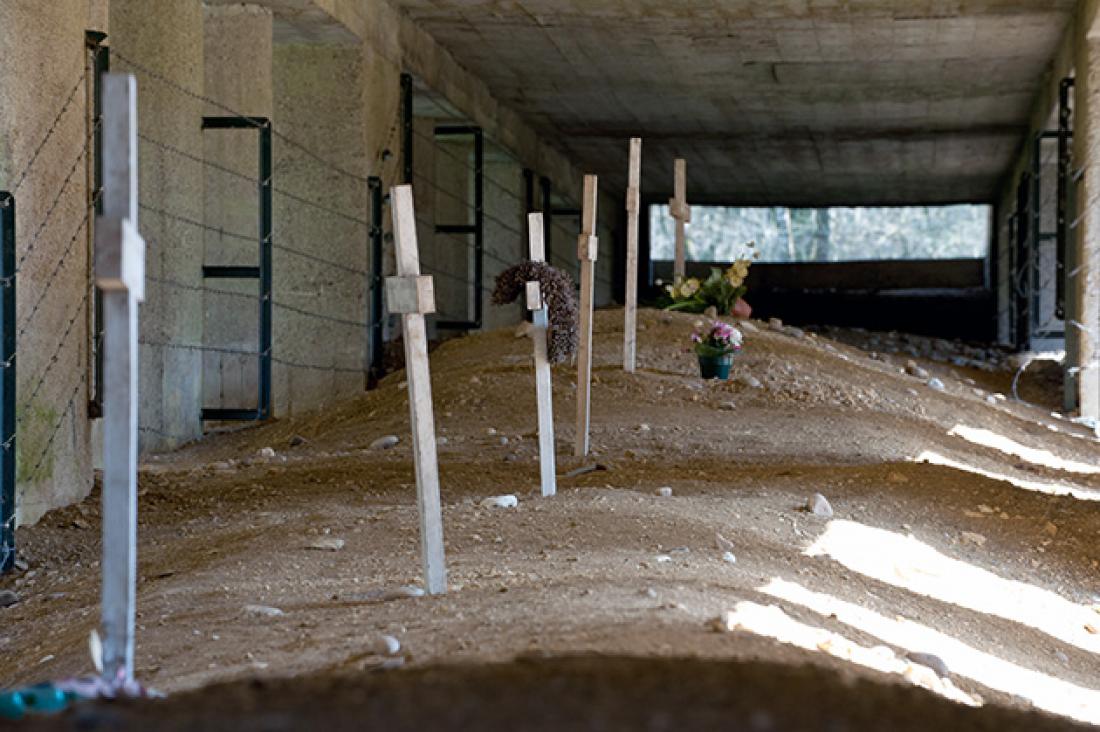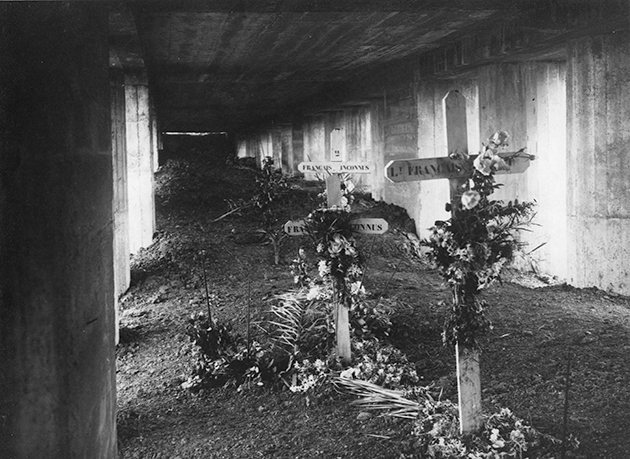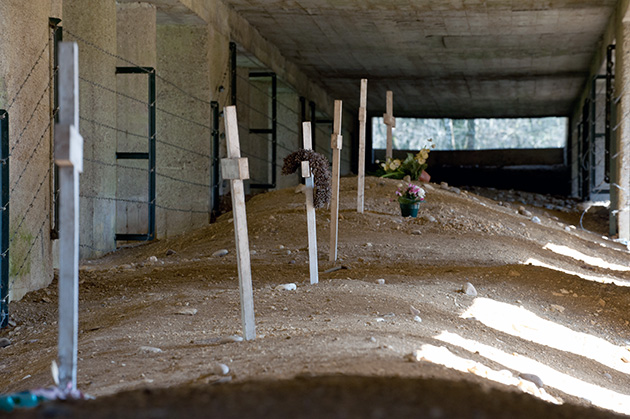Remembering the poilus: the Bayonet Trench

Another emblematic site of the First World War fighting is the Bayonet Trench, whose very origins make it differ from Notre Dame de Lorette: here, the soldiers’ bodies have not been gathered together in a purpose-built cemetery, but remain where they fell – a fact that situates the story of the Bayonet Trench between myth and reality.

The graves of the soldiers of the Bayonet Trench photographed between the wars. © Collection Mémorial de Verdun
In 1920, the “Bayonet Trench” memorial was erected. It was the first memorial to be built on the Verdun battlefield, where 700 000 men were killed or wounded in 1916. The Bayonet Trench recalls the sacrifice of the troops of the 137th Infantry Regiment (137th RI), whose regimental depot was at Fontenay-le-Comte in Vendée. They died on 11 and 12 June 1916, between Morchée wood and Thiaumont farm, in a position that backed onto the Ravin de la Dame, which the French troops nicknamed “Death Ravine”.
The monument, which, in March 2014, together with the cemetery of Fleury-devant-Douaumont, became one of the nine “Major National Remembrance Sites” of the Ministry of the Armed Forces, is a good illustration of the victorious, mythical aura surrounding remembrance in 1919.
A terrifying artillery bombardment took place on 11 June 1916, prior to a series of attacks being launched the following day. The attacks were partly pushed back, but the 3rd Company and part of the 4th Company of the 137th RI were left cut off in their position, separated by shell holes rather than an actual trench. The 3rd Company’s commander, Lieutenant Polimann, described what happened that day. By midday, he had only 25 men left in his command. He explains: “Those three waves came from the north; a fourth appeared in the west, but scarcely had it left its trench – about 80 metres away – than it was attacked from the flank by a lone machine gun, which did a marvellous job. So we had gained control, we were the victors – and yet, despite our success, we were cut off, imprisoned in an iron ring, which would tighten with each passing hour [...].” The next day, exhausted and low on ammunition, Polimann and his men surrendered, leaving behind their dead comrades, in one more episode of the hell of Verdun, where the regiment lost over 1500 men in June 1916. The Germans then hastily buried the dead in a disused section of the conquered trench – standard practice in the First World War – before continuing their advance. They most likely marked the site of the mass grave with a row of upended rifles.
In January 1919, Colonel de Bonnefoy, commanding officer of the 137th RI, returned to the battlefield and the place where his regiment had fought. There, he found a row of rifles, their bayonets removed, sticking out of the ground. After excavation of the site confirmed the presence of remains of soldiers of the 137th RI, a military parade was held and a small wooden memorial was erected to remember the events of “Rifle Trench”.
In 1920, a further excavation was carried out and 21 bodies were exhumed. Fourteen bodies were identified and transferred to the temporary cemetery at Fleury, before being moved to Douaumont cemetery. The seven unidentified bodies were left where they were. A row of rifles was once more put in place.
In the wake of the conflict, war tourism developed, as many came to visit the places where their relatives had fought and died. Bayonets were attached to the rifles and the site became known as “Bayonet Trench”. That is how the legend arose of soldiers being buried alive, still standing, by enemy artillery – a legend widely circulated by a press in search of sensationalism and heroic war stories. Touched by the story and moved by the solemnness of the site, American businessman George T. Rand donated 500 000 francs for a commemorative monument to be built. The monument consists of an imposing concrete slab supported by wide pillars, covering the trench where the seven unknown soldiers lie buried. It is reached via an avenue preceded by an impressive gateway. This narrow, sloping avenue recalls the soldiers’ climb up the support trenches to the line, and its focal point is a Latin cross symbolising the sacrifice of those who fought at Verdun. The ensemble was designed by architect André Ventre of the historic monuments department. The metal gate at the entrance is the work of artist blacksmith and arms manufacturer Edgar Brandt. The small memorial to the 137th RI has been preserved nearby.

The Bayonet Trench today. © A. Roiné / ECPAD / Défense
The Bayonet Trench memorial was unveiled on 8 December 1920 by French president Alexandre Millerand and US ambassador Hugh Wallace, in the absence of its patron, George T. Rand, who had died a short time before. It is dedicated to the “French soldiers who sleep on their feet, rifles in hand, in this trench”, thus officially setting the myth in stone.
At the end of the war, in a France ravaged by five years of bloodletting, the population sought tales of glory and heroism to justify all the sacrifices made during the conflict and show that all the suffering had not been in vain. A century later, historical information panels installed in front of the trench by the Directorate for Heritage, Remembrance and Archives offer visitors a better understanding of the site. But the myth of the “Bayonet Trench” continues to be passed on today, from remembrance tourist to remembrance tourist.
Nicolas Czubak, history and geography teacher, secondee at the Verdun Memorial education service, and a member of the scientific advisory board of the Verdun Memorial and Battlefield

